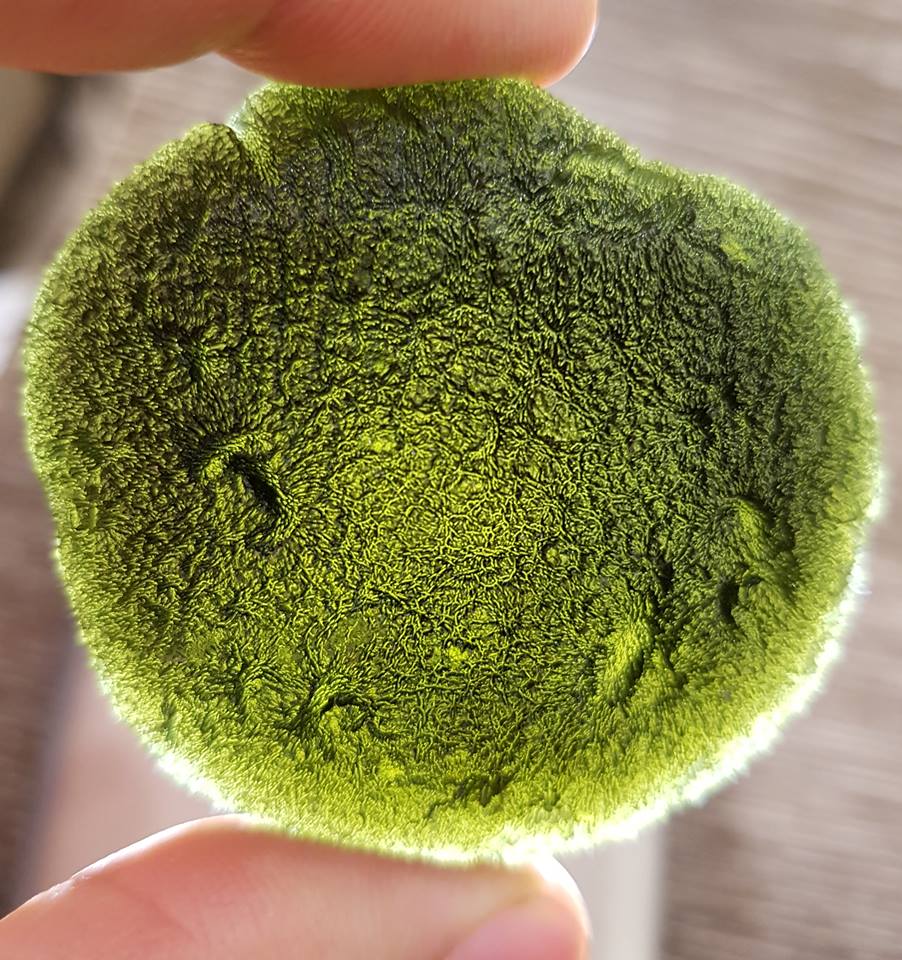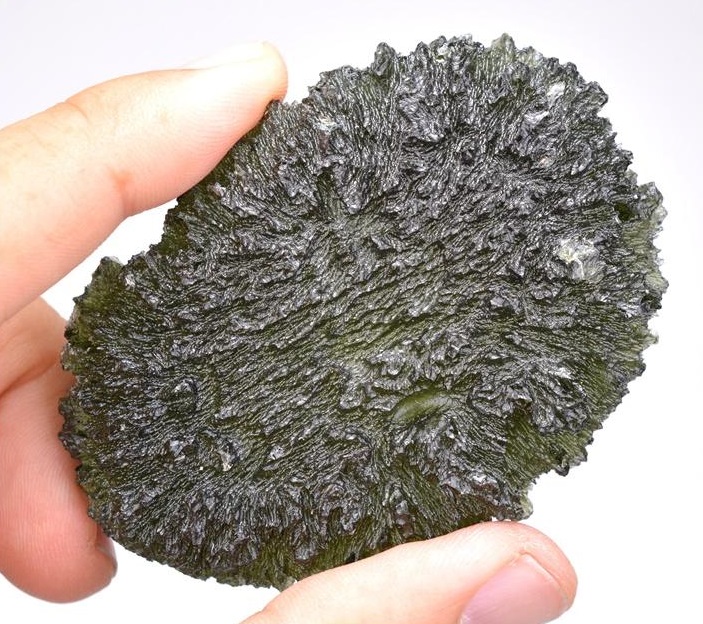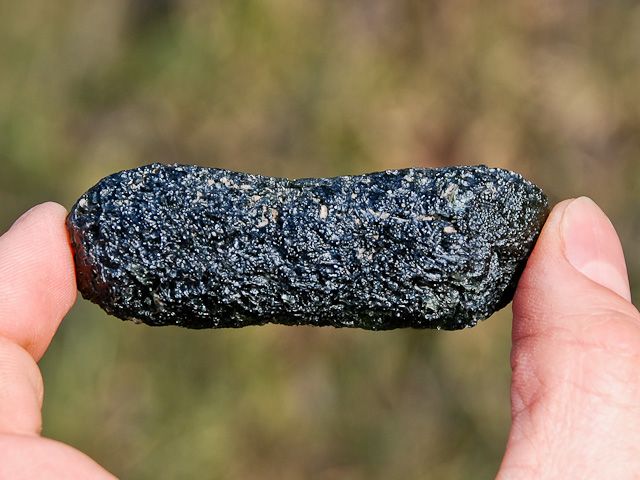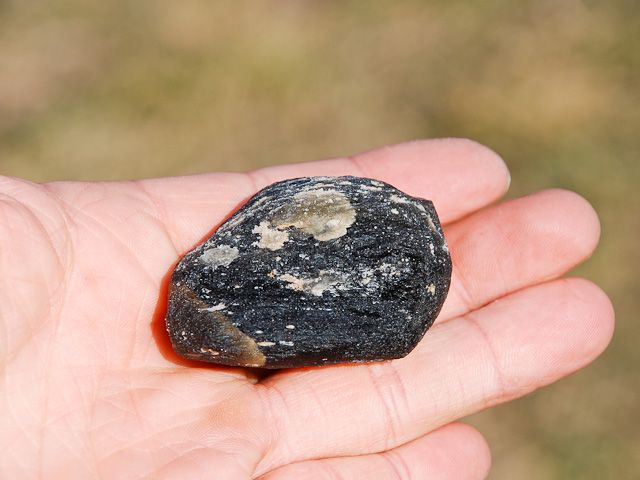Moldavite (called vltavín by the locals in the Czech Republic) is a natural impact glass called a tektite.
It was formed when a meteor hit Germany which formed the Ries crater and produced splash form and Muong Nong type Moldavite. For more information on the impact area, see www.stonesoftransformation.com.au/where-is-moldavite-found
The meteorite which created the Ries crater hit Earth at the velocity of 20km per second (i.e. the metorite traveled 20km every second!). The impact vaporized and melted the surrounding rock and ground.
Roughly 10^6 metric tons of Moldavite was formed approximately 14.8 million years go, with an estimated 1% of the original matter surviving to this present day. The majority of Moldavite has been eroded over millions of years and become part of the Earth.
To be more specific, Moldavite is a splash form tektite which are usually drop shaped(teardrop).
Imagine millions of molten drops of Moldavite flying through the sky like large rain drops after the meteor impact!
The majority of the drop shape Moldavite shattered on impact when landing at high speeds which have created other primary shapes such as disks and many other non-primary smaller shaped fragments. Moldavite has been further shaped by over 14 millions years of erosion with water and chemicals in the ground meaning each piece is as unique as a finger print.
Primary Shape Moldavites
Primary shapes includes drops (teardrops), discs, elliptical and dumbbells.
Primary shape Moldavite are rarer and form less than 1% of all pieces found.
Drop (tear drop) shape
Drop shape Moldavite – closest to the original splash form shape around 15 million years ago

Disk shape
Disk shape Moldavite with back light

Elliptical (oval) shape
Elliptical shape or oval shape Moldavite

Dumbbell shape
Dumbbells are the rarest of all primary form shapes. They are narrower in the middle and thicker on the sides.

Non-Primary Shapes
Non-primary shapes are the majority of Moldavite found. When Moldavite flew through the sky then hit the ground at thousands of kilometers per second, the majority of the splash form drops shattered into small fragments. The fragments have been further eroded over millions of years to form unique shapes.
Moldavite which is a smaller fragment of a larger piece does not effect the energy of the piece as they were all created with the same energy during an explosive impact.
Examples of non-primary shapes – fragments
Other types of Moldavite formation
Muong Nong type Moldavite
Muong Nong type Moldavite are layered tektites without internal stress usually characterised with a higher content of internal bubbles and foamy lechatelierite. This type of Moldavite is not common and often not as transparent or attractive.

All Moldavite is great!
The shape of Moldavite was influenced by various factors over the last 14.8 million years including mechanical (breaking, erosion, abrasion) and chemical which has caused surface sculpting. Everyone has their own preference of the shape or sculpting they like most. There is no one best shape or sculpting, but there are some which are rarer which mean higher prices. There are all kinds of sizes and shapes of Moldavite making it affordable for anyone interested.
Want more useful information?
See the guides:
Guide to Genuine and Fake Moldavite: www.stonesoftransformation.com.au/blog/fake-moldavite-guide/
The Best Guide on Spotting and Avoiding Fake Moldavite: www.stonesoftransformation.com.au/the-best-guide-on-spotting-and-avoiding-fake-moldavite/
Shapes of Moldavite: www.stonesoftransformation.com.au/blog/guide-to-the-shapes-of-moldavite/
Busting myths of Moldavite: www.stonesoftransformation.com.au/busting-some-myths-of-moldavite/
Other useful guides and blog posts: www.stonesoftransformation.com.au/blog/list-of-useful-posts/
Follow our Facebook page for updates on great information: www.facebook.com/StonesofTransformationMoldaviteStore
Customer reviews: www.stonesoftransformation.com.au/reviews/
Shop and sale page: www.stonesoftransformation.com.au/shop/










I am interested in buying real moldavite!
You’re so interesting! I don’t suppose I’ve read through anything like that before. So great to find someone with a few unique thoughts on this subject. Really.. many thanks for starting this up. This web site is something that’s needed on the internet, someone with a bit of originality!
Hi there, just wanted to say, I liked this article. It was funny. Keep on posting!
Your style is so unique compared to other folks I have read stuff from. Thank you for posting when you have the opportunity, Guess I will just bookmark this web site.
This website was… how do I say it? Relevant!! Finally I have found something which helped me. Kudos!